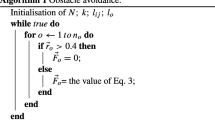Abstract
Self-organized flocking of robotic swarms has been investigated for approximately 20 years. Most studies are based on a computer animation model named Boid. This model reproduces flocking motion by three simple behavioral rules: collision avoidance, velocity matching, and flock centering. However, flocking performance depends on how these rules are configured and no guideline for the configuration exists. This paper investigates real robot flocking where individuals can switch their roles depending on the situations. Robots can move as leaders or followers, and the roles are dynamically allocated using stochastic learning automata. The flocking performance is evaluated, and swarming behavior is analyzed in a scenario where robots consecutively travel between two landmarks.








Similar content being viewed by others
Explore related subjects
Discover the latest articles, news and stories from top researchers in related subjects.References
Parrish K, Viscido SV, Grünbaum D (2002) Self-organized fish schools: an examination of emergent properties. Biol Bull 202(3):296–305
Şahin E (2005) Swarm robotics : from source of inspiration to domain of applications, swarm robotics, SAB2004 International Workshop, Santana Monica, CA, USA, July 2004. Revised Selected Papers, LNCS 3342:10–20
O. Soysal, and E. Şahin (2005) Probabilistic aggregation strategies in swarm robotic systems. In: Proc. of the 2005 IEEE Swarm Intelligence Symposium, pp 325–332
Liu W, Winfield AFT, Sa J, Chen J, Dou L (2007) Towards energy optimization: emergent task allocation in a swarm of foraging robots. Adapt Behav 15(3):289–305
Groß R, Dorigo M (2009) Towards group transport by swarms of robot. Int J Bio-Inspired Comput 1(1–2):1–13
Turgut AE, Çelikkant H, Gökçe F, Şahin E (2008) Self-organized flocking in mobile robot swarms. Swarm Intell 2(2–4):97–120
Ferrante E, Turgut AE, Mathews N, Birattari M, Dorigo M (2010) Flocking in stationary and non-stationary environments : a novel communication strategy for heading alignment. Lect Notes Comput Sci 6239:331–340
Reynolds C (1987) Flocks, herds and schools: a distributed behavioral model, computer graphics, vol 21, no.4 (Proceedings of ACM SIGGRAPH ’87). ACM Press, pp 25–34
Lukeman R, Li YX, Edelstein-Keshet L (2010) Inferring individual rules from collective behavior. Proc Natl Acad Sci 107(28):12576–12580
Çelikkanat H, Şahin E (2010) Steering self-organized robot flocks through externally guided individuals. Neural Comput Appl 19(6):849–865
Author information
Authors and Affiliations
Corresponding author
Additional information
This work was presented in part at the 1st International Symposium on Swarm Behavior and Bio-Inspired Robotics, Kyoto, Japan, October 28–30, 2015.
About this article
Cite this article
Toshiyuki, Y., Nakatani, S., Adachi, A. et al. Adaptive role assignment for self-organized flocking of a real robotic swarm. Artif Life Robotics 21, 405–410 (2016). https://doi.org/10.1007/s10015-016-0331-4
Received:
Accepted:
Published:
Issue Date:
DOI: https://doi.org/10.1007/s10015-016-0331-4




